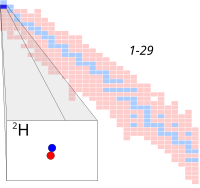
Photo from wikipedia
Positive muons can be implanted into silicon carbide (SiC), where they model the isolated hydrogen defect in the negative, neutral, or positive charge states and act as either an acceptor… Click to show full abstract
Positive muons can be implanted into silicon carbide (SiC), where they model the isolated hydrogen defect in the negative, neutral, or positive charge states and act as either an acceptor or a donor with midgap energy levels [Lichti et al., Phys. Rev. B 70, 165204 (2004); Lichti et al., Phys. Rev. Lett. 101, 136403 (2008)]. The charge states evolve after implantation depending on the temperature and material doping. We have measured optically induced effects on muons implanted in 6H-SiC using a pulsed, tunable laser [Yokoyama et al., Rev. Sci. Instrum. 87, 125111 (2016)]. In n-type 6H-SiC at 85 K and 40 K, with a laser pulse of energy below the bandgap, we observe photoionization of the doubly occupied level ( Mu −) to the neutral defect Mu 0 and also ionization of Mu 0 to Mu +. Varying the timing of the laser pulse relative to muon arrival confirms that the laser interacts directly with the muons in a stable or metastable state. There is no evidence of any interaction when the laser pulse is timed to arrive before the muons, so either few free carriers are generated by absorption at other dopant sites or the excess carriers have a very short lifetime ( ≪ 100 ns). Wavelength scans show absorption edges corresponding to the possible interstitial sites within the structure. Combining these data and the existing muon results shows that at low temperature, we have co-existence of Mu 0 and Mu − charge states, with the muon or hydrogen acting as a deep compensating impurity. The technique can be applied to many other semiconductors where the muon has been observed to be electrically active, modeling hydrogen.
Journal Title: Journal of Applied Physics
Year Published: 2020
Link to full text (if available)
Share on Social Media: Sign Up to like & get
recommendations!